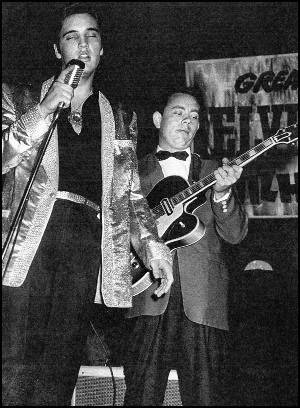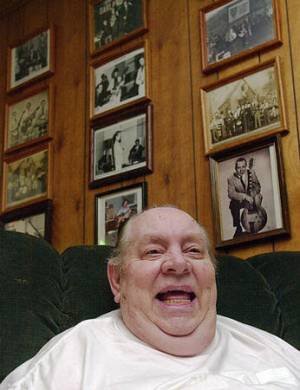DAVE'S DIARY - 5 JANUARY 2005 - HANK GARLAND RIP
HANK GARLAND RIP AT 74
BORN WALTER LOUIS GARLAND - COWPENS, SOUTH CAROLINA - NOVEMBER 11, 1930
DIED ORANGE PARK, FLORIDA DECEMBER 27, 2004
HANK JOINS HANK IN HONKY TONK HEAVEN
|
|
Famed
country jazz guitarist Hank Garland died late in December of 2004
after a brilliant career that was decimated by a mystery car accident. Garland died of a staph infection at Orange Park Medical Centre, according to his brother, Billy Garland. It was a sad end to the life of the guitarist who claimed the earlier car accident, at the peak of his career in September of 1960, was an attempt on his life. Garland remained in a coma in hospital for many months after the horrific crash that followed a bitter quarrel with his wife. Garland worked with Elvis from 1957 to 1961. He was playing on the soundtrack for the movie Follow That Dream when his 1959 Chevy Nomad station wagon crashed near Springfield, Tennessee, throwing Garland from the car and leaving him in a coma for months. |
Billy Garland claims it was no accident, but an attempted hit by someone in the Nashville record scene.
BULLET HOLES IN CAR
Garland had
photos showing bullet holes in the car.
The gravity of his injuries, combined with 100 electro-convulsive therapy
treatments administered by a Nashville hospital, left Garland a shadow
of his former self.
Billy said he didn't know who ordered his brother's shock treatments,
but they left him with little short-term memory.
"You don't take a man's brains away from him," Billy Garland
said.
A hospital report contains the notation: "He has no memory now. He's
retarded."
Hank had to relearn everything, from walking and talking to playing the
guitar.
But he could no longer muster the aggression that fuelled his talent and
could sustain his concentration only for short periods of time.
Sadly the second half of his life was spent in obscurity and dogged by
ill-health.
Garland spent his final years battling record companies for royalties.
Shortly before his death he filed a federal lawsuit over authorship of
the 1957 Christmas song Jingle Bell Rock, which he claimed, he
had co-written with Bobby Helms.
And for the second time since he quit playing, the Garland family was
reviewing a movie script based on Hank's life.
It's called Crazy but so far there are no firm deals to make it.
A previous movie deal, starring Jerry Reed as Hank, fell through.
Hank's wife predeceased him. There were two children from the marriage.
CHILD PRODIGY
Hank was
born Walter Louis Garland at Cowpens, South Carolina, a small town steeped
in the country music tradition.
He first began to play the steel-stringed guitar at the age of six, and
by his teens he was displaying a prodigious talent in local bands.
Hank also ascended to radio shows at 12.
During this period he began to use an electric guitar and to develop the
furious boogie licks that were to become his trademark.
"He was born with talent," said Billy Garland. "A God-given
talent."
Hank was just 14 when discovered in 1945 plucking on a guitar in a music
shop.
He caught the ear of Paul Howard, whose band, the Arkansas Cotton Pickers,
had a regular slot at the Grand Ole Opry.
Impressed by his technique, Howard invited the boy to join the band at
the Opry, but after his first spectacular performance, the Musicians'
Union discovered that Garland was under age, and he was sent back to Cowpens.
On the day he turned 16, Garland received a call from Howard summoning
him back to Nashville to embark on a recording career.
A young Chet Atkins noticed the skill of Garland, despite his youth, at
both acoustic and electric guitar.
"He was one of those guys," Atkins said later, "who you
could play a lick for and he'd come back like an echo. He had such a good
ear."
SUGARFOOT RAG
He made his
first recordings with Howard's band before a two-year spell with the Cowboy
Copas Band.
Garland began working as a freelance session musician.
At the age of 19 he recorded the guitar sound for Sugarfoot Rag
to accompany lyrics sung by Red Foley.
The record became a huge hit, selling more than a million copies and earning
Garland the nickname Sugarfoot.
Garland was much in demand to accompany the many popular, country and
jazz acts that were recording in Nashville.
Despite his relative youth, he acquired a reputation as a quick-tempered,
opinionated and obsessive musician who had little time for music producers
and their views.
"If they said something smart to him," Chet Atkins recalled,
"his face would get real red and he'd say something back. But he
was such a good musician that everyone had a terrible amount of respect
for him, so nobody stepped on his toes."
ELVIS PRESLEY AND PATSY CLINE
 |
By
the 1950s Garland was the hottest picker in Nashville and hired
for recordings by Jim Reeves, Conway Twitty and the Everly Brothers,
for whom he played on Bye, Bye Love. |
He accompanied several Presley hits, including A Fool Such As I, It's Now Or Never, Are You Lonesome Tonight, Little Sister and Big Hunk of Love.
He also performed
several times on stage with the singer.
At Presley's farewell concert show in Honolulu in 1961 Elvis introduced
him as "one of the finest guitar players anywhere in the country
today".
Garland returned the compliment by describing Presley as "real nice".
Elvis gave Hank the ukulele that he played in the movie Blue Hawaii.
Garland worked with Elvis from 1957 to 1961 and participated in Elvis's
Jailhouse Rock concert in Memphis, Tennessee.
JAZZ AND ROCK
In 1961,
in addition to his session work, Garland was making a name for himself
as both a jazz player (having recorded Jazz Winds From a New Direction
in 1960)
He also co-created (with Billy Byrd) the Byrdland electric guitar for
Gibson in 1954.
Garland was also at the forefront of the rock 'n' roll movement.
Hank was a true eclectic picker.
He enjoyed a prestigious career as a country virtuoso, pioneered the electric
guitar at the Grand Ole Opry and inspired jazz instrumentalists such as
George Benson.
Hank also jammed in New York City with George Shearing and jazz great
Charlie Parker.
His sessions included a Who's Who of the stars of country music, including
Brenda Lee, Web Pierce, Bobby Helms, Kitty Wells, Johnny Horton, Mel Tillis,
Ray Price, Marty Robbins, Eddy Arnold, Jim Reeves, Hank Snow, Porter Wagner,
Boots
Randolph, Conway Twitty, Hank Williams..
Further info www.hankgarland.com
